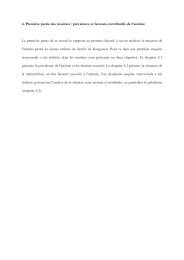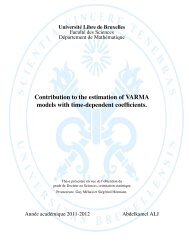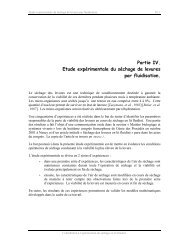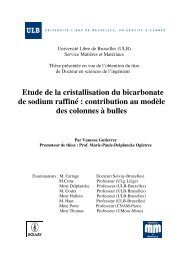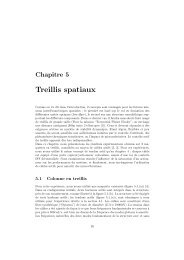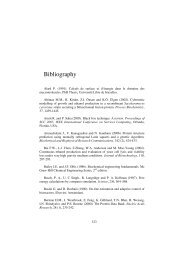Diapositive 1 - de l'Université libre de Bruxelles
Diapositive 1 - de l'Université libre de Bruxelles
Diapositive 1 - de l'Université libre de Bruxelles
Create successful ePaper yourself
Turn your PDF publications into a flip-book with our unique Google optimized e-Paper software.
Chapitre IVThese results suggest that, in echino<strong>de</strong>rms, sulphur is mainly inclu<strong>de</strong>d in the mineralphase of the skeleton. This hypothesis is further supported by the fact that the totalmeasured sulphur concentrations (ca. 3500µg/g) are higher than the total organic matrixconcentration of echino<strong>de</strong>rm skeletons. In<strong>de</strong>ed, the total protein matrix concentration ofP. lividus test is estimated to 0.15 to 0.2 % w.w. of the skeleton (Weiner 1985), which isequivalent to 1500 to 2000 µg/g. Polysacchari<strong>de</strong>s account for ca. 15% of the matrix(Swift et al 1986) and do not change this figure significantly. So, in echino<strong>de</strong>rms, most ofthe sulphur is in the mineral phase of the skeleton. It can be present in carbonate assulphate substituted to carbonate, as a distinct mineral phase or as an impurity entrappedin the skeleton during calcification. Busenberg & Plummer (1985), Pingitore et al (1995)and Kampschulte & Strauss (2004) suggested that mineral sulphur was substituted in themineral phase of biogenic calcite. More recently, microRaman spectra published byBorzecka-Prokop et al (2007) showed sulphate vibrational bands in the skeleton of P.lividus. Furthermore, the substitution of sulphate to carbonate in abiogenic calcite wasrecently established by Kontrec et al (2004). This suggests that sulphur could be presentin echino<strong>de</strong>rm skeleton as sulphate substituted to carbonate.Even if sulphur was shown to be predominantly present in the mineral phase ofechino<strong>de</strong>rm skeleton, its co-occurrence in the organic phase was confirmed by FTIR andXANES analysis performed on extracted organic matrix. Detected organic sulphur formswere S-containing amino acids and sulphated sugars. Amino acid analyses of P. lividusand A. rubens intraskeletal matrix were performed in previous studies (Weiner 1985,Dubois, unpublished) and showed the presence of methionine and the absence of cystein.Sulfated polysacchari<strong>de</strong>s were suggested to cooperate with carboxylate groups inattracting Ca 2+ ions (Addadi & Weiner 1992).Sulphur being mainly associated with the mineral phase, how is it incorporated into thisphase and related to magnesium? Sulphate is a major ion in seawater (2712 mg/L at asalinity of 35 psu, Libes 1992). The major part of seawater sulphates are present as freeions (54%) and as magnesium and sodium paired ions (respectively 21.5 and 21%, Libes1992). Sulphates are also present in animal inner fluids: concentrations of ca. 2497 mg/lhave been measured in coelomic fluid of different echino<strong>de</strong>rm species (Shumway 1977).Ion pairing between sulphates and magnesium could explain the correlation between theincorporation of these elements. In<strong>de</strong>ed, magnesium in solution forms strong bonds with91



